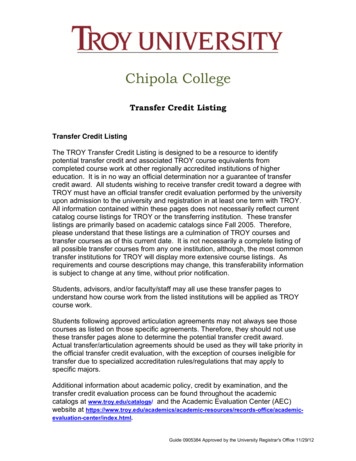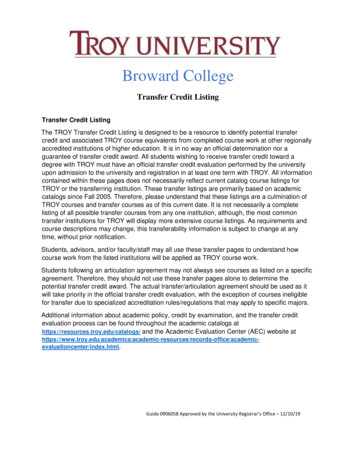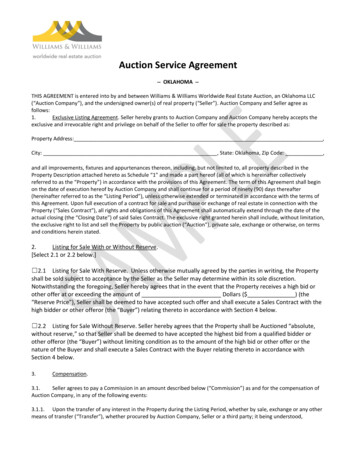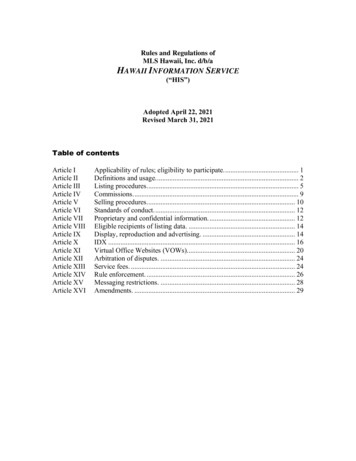
Transcription
A Guide to Listing& the IPO Processin Australia
ContentsIntroduction3The decision to list7Eligibility to list11Indicative IPO timeline16Preparing for an IPO19The prospectus25The due diligence process31Offer, structure, pricing & marketing restrictions35Engagement with ASX39Foreign companies listing on ASX43Ongoing obligations49Authors52Our broader team53About Maddocks54Maddocks A Guide to Listing & the IPO Process in Australia1
IntroductionHeadquarters of Australian Securities Exchange, Sydney NSW AustraliaA Guide to Listing & the IPO Process in Australia aims to assistcompanies in determining whether they qualify for an AustralianSecurities Exchange (ASX) listing. It will also help with understandingwhat is involved in the initial public offering (IPO) process by providingsome practical guidance on how to prepare for an IPO.2A Guide to Listing & the IPO Process in Australia MaddocksThis guide is intended to be an overview of some of the key criteria forlisting and the process involved to help companies to decide whetheran ASX listing may be a growth option for them, not as a comprehensivesummary of all the steps and requirements involved in an ASX listing.It is based on the ASX Listing Rules and guidance that came into effectin September 2018. However, readers should be aware that ASX isproposing to introduce a number of changes to the Listing Rules in2019 which will have some impact on the IPO process and ongoingobligations as a listed company.Maddocks A Guide to Listing & the IPO Process in Australia3
Why ASX?How can Maddocks assist?Many growing and successful private companiesconsider listing on the ASX via an IPO atsome stage in their development as a routeto accelerate growth and to open up newopportunities for their business.Maddocks has an excellent track record assistingcompanies to make the decision to list andmanaging the legal aspects of the IPO process.We also have close working relationships with:IPOs per yearmarket capitalisationIn addition, numerous foreign companies list onASX (either as a primary or dual listing) to accessthe Australian capital markets. Private equity andventure capital investors often work towards anIPO as an exit mechanism for their investment.The ASX has over 150 years of exchangeexperience and is one of the world’s leadingexchange groups. Operating in a robustregulatory environment, the ASX has over 150years’ of exchange experience and is one of theworld’s leading exchange groups.As a highly active capital market, the ASXregularly attracts over 100 IPOs each year andprovides companies with access to the largestpool of investable funds in Asia.Currently, the ASX has over 2,200 listedcompanies and issuers across diverse sectors,with a market capitalisation of more than 2trillion. In addition, the ASX has 6.7 million shareowners and 180 market participants.1 average daily turnovershare ownerslisted companiesand issuersyears of exchangeexperienceboth ASX and the Australian Securities andInvestments Commission (ASIC) to help theIPO regulatory processcorporate advisers, investment banks,stockbrokers and accountants to ensure theIPO team works seamlessly to deliver anefficient IPO process.We aim to build long-term relationships with ourclients through their IPO and into their listed life.Our partners are recognised for their hands-onand commercial approach to the myriad legalissues involved in an IPO. Our national teamcan assist on all aspects of the IPO process,including: assessing whether the company is eligible tolist on ASXstructuring pre-IPO funding to flow into the IPOpreparing for an ASX listing by completinggroup reorganisations, implementing employeeincentive plans and formalising appropriatecorporate governance frameworksmanaging the due diligence process for the IPOdrafting certain sections of the prospectus andensuring that the prospectus and other offerdocuments meet regulatory requirementsseeking regulatory waivers and approvals fromASX and ASIC (in particular to facilitate foreignlistings)negotiating underwriting agreementsfollowing listing, supporting companies andboards to meet their disclosure, reporting andother obligations under the ASX Listing Rulesand Australian law.Source: asx.com.au; ASX Capital with confidence – A launch pad to accelerate your growth14A Guide to Listing & the IPO Process in Australia MaddocksMaddocks A Guide to Listing & the IPO Process in Australia5
The decision to listPatterns on building exterior at Federation Square, Melbourne, Victoria, AustraliaListing on any stock exchange presents a range of opportunities andchallenges for companies. The first step for a company considering anIPO and listing is to weigh up these factors having regard to its ownunique circumstances.6A Guide to Listing & the IPO Process in Australia MaddocksMaddocks A Guide to Listing & the IPO Process in Australia7
sing capitalLoss of controlAttracting & retaining employeesCurrent & future market conditionsAn IPO raises capital for current operations,refinancing and expansion. A listing also meansthat future equity capital raisings are simpler andcheaper. Listed securities can also be used asa currency for acquisitions and to support debtfinancing.Once a company completes an IPO, there isnecessarily some loss of control for ownersarising from dilution. In addition, ASX ListingRules require shareholder approval for manymatters that were previously under the controlof owners and management such as significantacquisitions or disposals, share issues andrelated party transactions.Equity incentive schemes in listed companiesare more attractive to current and prospectiveemployees and can drive employeeincentivisation, in turn benefiting the company.Share prices and liquidity for listed companiesare susceptible to general economic and marketconditions which are outside the control ofmanagement.Attracting institutional investmentCostsA public listing is the platform to attractinstitutional investors which provide a companywith market credibility and the support to growits business. Compulsory superannuation inAustralia means that Australian institutions haveaccess to one of the largest investment pools inthe world.The IPO process involves significantunderwriting, professional adviser and ASX listingfees in addition to other service fees and costs.Maintaining a listing also involves ongoing costssuch as audit costs, share registry fees, annualASX listing fees and annual general meetingcosts.Creating a market for the company’s sharesCultural change & privacyA public listing will create a market for trading inthe company’s shares, thereby creating “liquidity”in the shares. Liquidity is attractive to a widersection of the investment community and willultimately broaden the shareholder base.There is a risk that the required changes tocompany structure, management and processesto enable it to operate as a listed company, mayaffect internal culture. There is also necessarilya loss of privacy for publicly listed companies,caused by media interest and compliance withregulatory disclosure regimes.Raising the profile of the companyDiversion of management focusAn IPO provides a company with the opportunityto raise its profile in the media, as well as withcustomers, suppliers and investors, producingflow-on benefits to the company.The IPO process and the continuing operationof a company as a publicly listed company willrequire a significant investment of managementtime, and if not properly managed, could affectthe company’s business.Providing an exit-strategy for early investorsIncreased disclosure & corporate governanceAn IPO and listing of a company can provide adesirable or necessary exit for early investors inthe company. However, there may be restrictionswhich limit the number of shares that can be soldby founder shareholders, seed capitalists andother specified persons for a certain period afteran IPO (see Engagement with ASX).A listed company must comply withcomprehensive disclosure obligations, includingfinancial performance and managementremuneration. Complying with the ASX’scorporate governance regime can also seemburdensome for companies used to operating in aprivate environment.A Guide to Listing & the IPO Process in Australia MaddocksGreater efficiencies and transparencyThe continuous disclosure and corporategovernance requirements for listed companiesmay promote better internal processes andreporting mechanisms, which may in turn lead togreater efficiency and transparency.Maddocks A Guide to Listing & the IPO Process in Australia9
Eligibility to listThe Sydney Opera House, Sydney, NSW, AustraliaASX applies general tests and certain specific requirements for listing acompany. ASX also retains a general discretion not to list any companythat it does not consider suitable to be listed on its exchange. Whilstthis is a wide discretion, it is exercised in only exceptional cases andusually where companies are not at a sufficiently advanced stage ofdevelopment to list.10A Guide to Listing & the IPO Process in Australia MaddocksMaddocks A Guide to Listing & the IPO Process in Australia11
General testsSpecific requirementsASX must be satisfied that the company’sstructure and operations are appropriate for alisted entity. ASX considers (amongst others) thefollowing matters carefully:ASX also imposes a number of specific conditions for listing, including the following: Profits and assets testsA company must meet either the “profits test” or the “assets test”.capital structureBoard experiencelegality of operationsexperience of auditorsstructure of business operationsrelationships with related parties/entitiesstage of development of businessoperations in emerging markets.Profits test requirementsAssets test requirements ASX provides detailed guidance as to thesematters and Maddocks has extensive experiencein how ASX applies its guidance. For manycompanies, these general tests will not presentany issues. However, if there are any concernsabout potential eligibility, we can guide yourcompany through ASX’s pre-approval for listingprocess before you incur significant time andcosts in commencing the IPO process.A 1 million aggregated profit over past3 years; andA 500,000 consolidated profit over last 12months and continuing profitability A 4 million net tangible assets after deductingcosts of fundraising; orA 15 million market capitalisation3 years of audited accounts2 years of audited accountsReviewed accounts for the half year if the lastaudited accounts are more than 6 months and 75days oldReviewed accounts for the half year if the lastaudited accounts are more than 6 months and 75days oldA 1.5 million in working capital at listing and ASXordinarily also requires 12 months’ after listing(which can include forecast revenue if included inthe prospectus) 2A statement in the prospectus that the companyhas enough working capital to carry out its statedobjectivesIf a company lists under the assets test rather than the profits test, it will be subject to certain additionalrequirements following listing:Quarterly financial reportingThe company will be required to quarterly report its cashflows in addition to the standard half year andannual financial reporting if at the time of admission it has 50 percent or more of its tangible assets incash (or a form readily convertible into cash).The company will be subject to quarterly reporting for at least 2 years following listing or a longer periodif it is not cash-flow positive.Escrow (lock-up) of sharesFounder shareholders, seed capitalists and other specified early shareholders will usually be subjectto the ASX imposed mandatory escrow (or lock-up) arrangements for their shares following listing (seeEngagement with ASX below).This working capital requirement is expected to be clarified in the forthcoming changes to the ASX Listing Rules in 2019212A Guide to Listing & the IPO Process in Australia MaddocksMaddocks A Guide to Listing & the IPO Process in Australia13
Shareholder spread & free floatA company must satisfy the shareholder spread and free float minimums:Minimumnumber ofshareholdersAt least 300 shareholders with parcels of at least A 2,000 in value each, whichnumber cannot include escrowed shareholders (mandatory or voluntary) or affiliatedshareholders.Minimum freefloatAt least 20 percent of the company’s share capital (by value) must be held byshareholders who are not escrowed shareholders (mandatory or voluntary) oraffiliated shareholders.Board of DirectorsResidencyAustralian companies - must have at least three directors, at least two of whichmust be Australian residents.Foreign companies – whilst not mandated under the Listing Rules, ASX generallyrequires at least one Australian resident director.Good fameand characterAll directors must provide bankruptcy and criminal history checks and a statutorydeclaration relating to regulatory investigations for the previous 10 years in allcountries in which they have resided.ASX proposes to extend the “good fame and character” requirement for new listingsto CEOs in the changes to the Listing Rules due to be introduced in 2019.ExperienceThe Board should include directors with sufficient experience and expertise including: 14A Guide to Listing & the IPO Process in Australia Maddockslisted company experience (including ideally ASX board experience)experience managing a company in the applicable industryfinancial experience (including for audit committee participation).Maddocks A Guide to Listing & the IPO Process in Australia15
Indicative IPO timelineInitial meeting of the Due DiligenceCommittee and commenceprospectus draftingLatest date to lodge pathfinderand draft listing applicationwith ASXPrepare listingapplicationInitial discussionwith ASXAppointIPO teamInitial structuringmeetingsT – 18weeksT – 12weeksLodgement ofprospectus with ASICNegotiateunderwritingagreementIncorporate new public company andadopt ASX compliant constitutionT – 15weeksT – 16weeksCommencepre-marketingASX listingcommencesT – 10weeksT – �8weeksOfferclosesT – 10daysT–3weeksTDue diligence and prospectus draftingVerification of prospectusASIC exposureperiodOffer period16A Guide to Listing & the IPO Process in Australia MaddocksMaddocks A Guide to Listing & the IPO Process in Australia17
Preparing for an IPOMetal lattice detail on Webb Bridge, Melbourne, Victoria, AustraliaPreparing for a listing early is vital to ensure a successful and timely IPOprocess. Whilst the IPO process takes around 4-5 months from start tolisting, we recommend the company starts to address changes which mayneed to be made to the company, its processes and personnel in order tosmoothly transition to a listed company up to 12 months in advance.18A Guide to Listing & the IPO Process in Australia MaddocksMaddocks regularly engages with companies early to assist in the processof preparing for an IPO and can guide your company through many of thematters to be considered.Maddocks A Guide to Listing & the IPO Process in Australia19
Key action itemsTypically, the key action items include:Business plan It is important that the company has a clear idea of where it is heading. It shouldhave a business plan setting out its strategic objectives and course of action overthe next three to five years. The listing should fit within a broader direction andgrowth strategy for the company that is reflected in the business plan.Having a sound business plan documented and in place will also assist in preparingmarketing presentations, the prospectus and, ultimately, in securing investorconfidence.ManagementteamThe IPO process is very time consuming for senior management. Considerationshould be given to whether the existing management team has the skills andresources to take the company through the IPO process. Recruitment of additionalmanagement and training of existing management may be beneficial.Related party Identify any arrangements with directors, significant shareholders and their relatedarrangements entities and formalise if necessary (where they will continue following listing).Accountsand financialsystemsEnsure that three years of audited accounts are available (required for theprospectus), together with management accounts for the same period. Considerwhether the accounting and management reporting systems will be able to producequarterly (where applicable), half yearly and annual reports that comply with a listedentity’s disclosure obligations.CorporategovernanceThe ASX is a strong advocate of corporate governance and has issued detailed bestpractice corporate governance recommendations for all listed companies. Listedcompanies must report on their compliance with the recommendations both in theIPO prospectus and annually after listing. Whilst compliance is not mandatory, noncompliance must be explained and justified.Ensuring key personnel are locked-in and incentivised through the IPO processand beyond is critical. Establishing appropriate executive incentive plans aligned toshareholders’ interests for post-IPO attraction and retention of key personnel is anadvantage too.Compositionof the boardConsider whether the current board has a sufficient mix of skills and experience andhas an appropriate balance of executive, non-executive and independent directors.In particular, ASX focuses on: Grouprestructuringindependent directors - ASX guidance is that a majority of the board be comprisedof independent directors, however, this is not a mandatory requirementlisted company experience (ideally on ASX)financial expertise for the audit committee.At a minimum, companies will need to establish dedicated remuneration, nominationand audit and risk committees, and adopt a range of policies including a sharetrading policy, shareholder communication policy, code of conduct for managementand staff and a diversity policy.Pre-IPOfundingConsider whether a pre-IPO funding round is necessary or desirable. This may berequired to ensure that there is not unnecessary pressure on the IPO timetable,allowing you to go to market when conditions are favourable. Alternatively,if conducted in Australia, a pre-IPO funding round can be seen as an initialintroduction to Australian institutional investors and can attract subsequent supportfor the IPO.Determining whether any restructuring is required before the IPO including: identifying which of the group’s assets will be part of the IPO and which will beexcludedunwinding private company appropriate capital structures (e.g. preference sharesand options/warrants)identifying the appropriate vehicle for listing (which could include interposing anew holding company or setting up a special purpose vehicle to accommodate asell-down by existing shareholders).Tax and accounting advice is vital in this process.20A Guide to Listing & the IPO Process in Australia MaddocksMaddocks A Guide to Listing & the IPO Process in Australia21
The IPO teamUnderwriterLegal advisersTechnical expertsIt is very important for a company which intends togo public to engage advisers who are familiar withIPOs and listing to ensure a smooth transitionto the public arena. Engaging with professionaladvisers at an early stage is the most effectiveway to identify any potential issues with the IPOand minimise costs.An underwriter agrees to buy any shares thatare not subscribed by investors during the IPO,giving the company certainty that it will achieveits targeted capital raising. While many mediumto large IPOs tend to be underwritten, there is norequirement for underwriting. Ordinarily, one ormore of the Lead Managers will also underwritethe offer.Legal counsel will advise on all legal aspects ofthe IPO, with their focus on conducting the legaldue diligence, advising on the content of theprospectus and managing regulatory engagementwith ASX and ASIC. Legal counsel will alsonegotiate any underwriting agreement on behalfof the company.Depending on the nature of the company’sbusiness, the prospectus may require theinclusion of one or more expert reports to explainaspects of its business in order to meet thelaws on prospectus content. This is particularlyrelevant for mining, biotech, medical and realestate businesses.AccountantsPublic relations / communications consultantsAccountants will conduct financial due diligence,review the financial information to be includedin the prospectus and provide the investigatingaccountant’s report for inclusion in theprospectus. In addition, accountants may providetax advice and a valuation of the company’sassets. If financial forecasts are to be includedin the prospectus, the accountants will need tosign-off on the forecasts, which can significantlyincrease the work required.A public relations or communications consultantmay be appointed to manage the marketing of theIPO, in addition to assisting the company withinvestor relations as a listed company.The following advisers commonly feature on anIPO team:Corporate adviser, investment bank orstockbrokerA corporate adviser, investment bank orstockbroker, usually known as “Lead Managers”,manages the overall IPO process for thecompany, to the offer. In particular they usually: provide market analysis to the companyprovide a valuation of the companyadvise on the structure of the IPO, the offerprice, size and timing manage marketing roadshows identify institutional investors and manage theraising to ensure that the shareholder spreadand free float tests are met manage settlement of the offer manage the drafting of the prospectus andmarketing materials.In some circumstances post-listing, they may alsoissue investor research on the company.The underwriter will not sign the underwritingagreement until after successful investorroadshows have been completed and theunderwriter has near certainty that the offer willbe fully subscribed. This is normally immediatelybefore the prospectus is lodged with ASIC.It is common market practice for an underwriter torequire certain shareholders and key managementpersonnel to enter into voluntary escrow (lock-up)agreements in relation to their shareholdings toassist in marketing the IPO to investors. Voluntaryescrow is different to ASX mandatory escrow,which applies to certain types of early investors(see Engagement with ASX below) for assetstest companies. Voluntary escrow arrangementsare typically shorter than mandatory escrowperiods and are a matter of negotiation betweenthe company and the underwriters to achieve abalance between ensuring an orderly market afterlisting and achieving adequate levels of liquidity.Share registryA share registry will be appointed to assist withsettlement of the offer and manage the register ofshareholders after the IPO.For larger IPOs, there is usually a combination ofbanks and brokers acting as Joint Lead Managersto the IPO.22A Guide to Listing & the IPO Process in Australia MaddocksMaddocks A Guide to Listing & the IPO Process in Australia23
The prospectusAbstract architecture in Sydney, NSW, AustraliaA company will ordinarily be required to prepare a full prospectus underwhich it will offer shares to the public on its IPO. However, in certaincircumstances, such as a dual listing of a foreign company where thecompany is not looking to raise capital at the time of the listing, ASX willinstead permit the company to prepare an information memorandum with alower disclosure threshold. This section addresses the requirements for afull prospectus.24A Guide to Listing & the IPO Process in Australia MaddocksMaddocks A Guide to Listing & the IPO Process in Australia25
General content requirementSpecific disclosure requirementsThe legal requirement is that a prospectus mustcontain all information that investors (and theirprofessional advisers) would reasonably require,and reasonably expect to find in the prospectus,to make an informed assessment of materialmatters relating to the company including:There are certain specific disclosure requirements contained in the Corporations Act 2001 (Cth)(Corporations Act), ASIC guidance and the ASX Listing Rules, the most important of which include: the assets and liabilities, financial position, profitsand losses and prospects of the companythe rights attached to the securities being offered.The content to meet this general test will bedetermined by the nature of the company’sbusiness, industry guidelines and standards,market practice, ASIC regulatory guidance andASX Listing Rule requirements. Prospectusesnormally exceed 100 pages.In practice, a balance needs to be struck in theprospectus between presenting the companyand its business in the best possible light formarketing purposes and the risk of substantialpenalties in the event that the prospectuscontains misleading information or omits materialinformation.Although there is no express exception forconfidential information in the prospectusdisclosure requirements, this will not automaticallymean that you need to disclose commerciallysensitive information or trade secrets. The testis what is relevant and reasonable for investorsto expect. Careful analysis and weighing of theusefulness of the information to investors versuscommercial harm is required.Finally, there is a requirement that a prospectusmust be presented in a ‘clear, concise andeffective’ manner so that investors (including, inparticular, retail investors) can understand thepotential opportunities and risks associated withan investment in the company.26A Guide to Listing & the IPO Process in Australia MaddocksInvestment OverviewThe prospectus must have an Investment Overview at the start whichprovides a balanced summary of the contents of the prospectus,including the key highlights and risks associated with the business.Business modelThe prospectus should explain the main components of your businessmodel and include a substantive analysis of the components and thekey assumptions underlying the company’s business model.RisksThe prospectus should explain the risks associated with yourbusiness model and the risks associated with the offer. Riskdisclosure must be specific rather than general and the likelihoodand consequences of risks occurring analysed. Risks must be givenprominence in the prospectus.Financial informationThe prospectus must ordinarily include three full financial years ofhistorical information or 2.5 years if the financial year end was morethan 6 months and 75 days before the prospectus date.Forecast financial information may also be included where this ismaterial to an investor’s investment decision.The prospectus should explain whether directors and key managersBoard and managementand their remuneration and have appropriate expertise and background. Any bankruptcy, orcriminal convictions and regulatory investigations relevant to ainterests in securitiesdirector’s role will need to be disclosed. In addition, details ofremuneration arrangements, interests in existing securities andpotential rewards under incentive schemes must be disclosed.Related partyarrangementsDetails of all material related party arrangements and how these mightconflict with the interests of the investor must be disclosed.Terms of securitiesThe prospectus must summarise the terms of the securities beingoffered to investors, including voting rights, dividend rights etc.Interests of advisersA prospectus must disclose the interests of and payments to certainadvisers to the company.Maddocks A Guide to Listing & the IPO Process in Australia27
Financial information andforecastsInformation about the company’s financialposition, performance and prospects is oftenthe most important consideration for investors.In addition to the historical and pro-formafinancial information which must be included ina prospectus to explain the assets and liabilities,financial position, profits and losses of thecompany, a key issue for many companies iswhether to include forecast financial information.Whether forecasts should be included in theprospectus will often depend on the stage ofdevelopment of the company. Forecast financialinformation will likely be of interest to potentialinvestors and can be beneficial to the valuationobtained for the company. However, in certaincircumstances companies may not have areasonable basis for including such forecasts. Forexample, earlier stage or high growth companiesmay not have sufficient certainty to forecastperformance reliably, particularly where newproducts or services are being launched into themarket during the period post-listing.If forecasts are included, careful analysis mustbe undertaken and detailed disclosure of allassumptions underpinning the forecasts and theirreasonableness must be made. In the absence ofreasonable grounds for any prospective financialinformation and other forward-looking statementsincluded in a prospectus, the information orstatements will be deemed to be misleading.ASIC reviewPathfinder prospectusThe final prospectus must be lodged with ASICbefore the offer can open. ASIC will not pre-vet aprospectus before lodgement, although specificqueries or concerns can be raised with them at anearlier stage.It is common for investment banks and brokersto seek to distribute a pathfinder prospectusas part of the marketing process for an IPO. Apathfinder prospectus is a near final version ofthe prospectus which is used to allow certaininstitutional investors to consider the company,the IPO and valuation before the lodgement of theprospectus with ASIC and can be used as part ofthe process to finalise pricing of the offer.ASIC has a 7-day ‘exposure period’ which it canextend to 14 days to review the prospectus. ASICundertakes a detailed review of the prospectus,both in terms of content and presentation. It iscommon even for the most meticulously preparedprospectus to receive comments from ASICrequiring amendment. These can usually beaddressed quite quickl
2 A Guide to Listing & the IPO Process in Australia Maddocks Maddocks A Guide to Listing & the IPO Process in Australia 3 Introduction A Guide to Listing & the IPO Process in Australia aims to assist companies in determining whether they qualify for an Australian










